Key takeaways
- French photography captures the essence of emotion and storytelling, blending elegance with spontaneity.
- Portfolios serve as crucial visual resumes, showcasing a photographer’s unique perspective and evolving style.
- Effective fashion photography emphasizes timing, connection with the atmosphere, and the interplay of light and perspective.
- The experience at events like Cannes highlights the importance of personal engagement and the narrative behind each fashion piece.
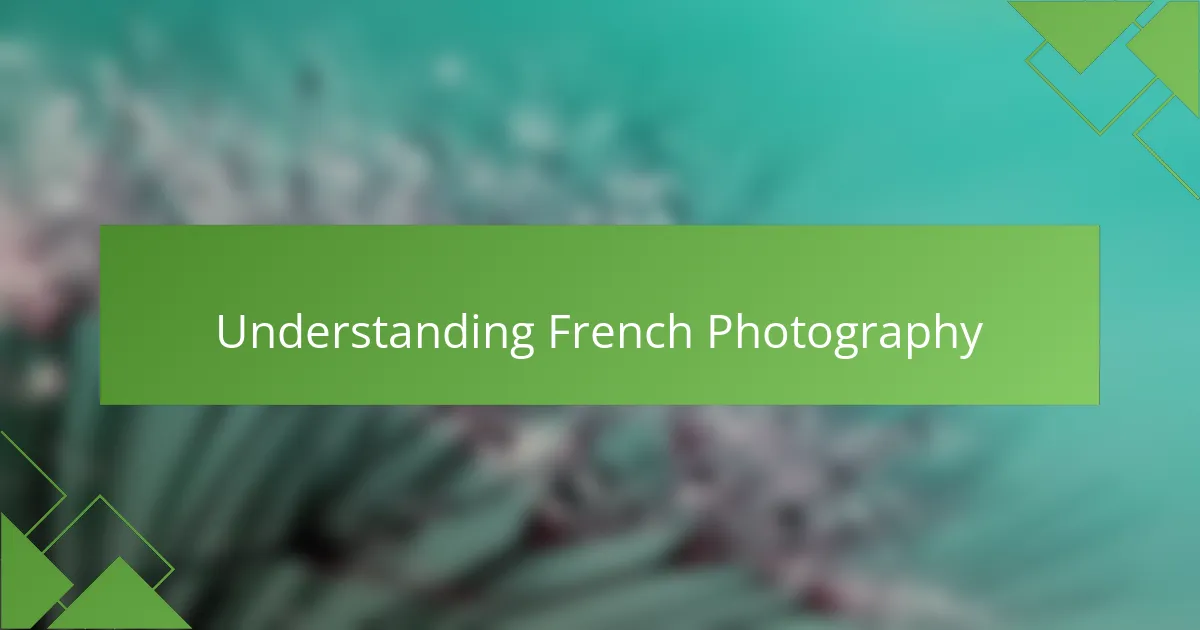
Understanding French photography
Understanding French photography involves appreciating its deep roots in culture and creativity. From the striking landscapes captured by early photographers to the modern interpretations seen today, French photography is a narrative of life, emotion, and artistry. Personally, I’ve found that the ability to evoke feelings through imagery is one of the most compelling aspects of this art form. It’s like a conversation where the photograph speaks a thousand words without uttering a sound.
French photographers often blend elegance with an essence of spontaneity. For instance, during my visits to art exhibitions in Paris, I noticed how even candid shots have a certain grace that feels uniquely French. This balance is what drew me to exploring fashion photographers in events like Cannes, where the vibrancy of fashion meets the classic aesthetic of French photography.
| Aspect | French Photography |
|---|---|
| Emotional Resonance | Focus on feelings and storytelling |
| Innovation | Blending tradition with modern techniques |
| Style | Elegance rooted in spontaneity |
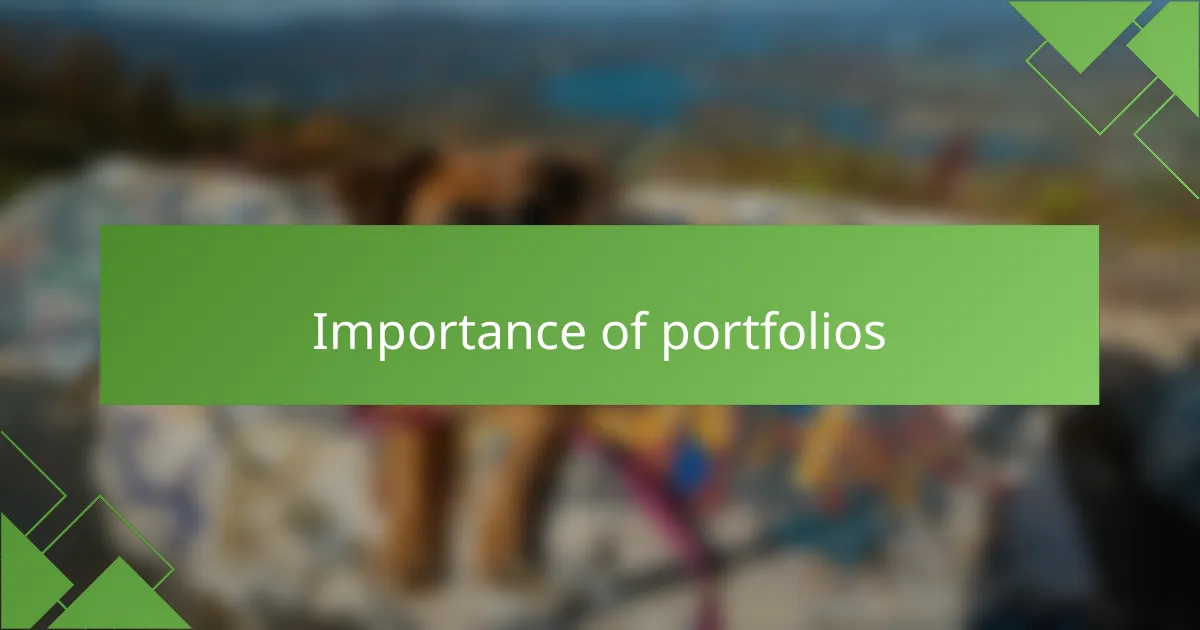
Importance of portfolios
Portfolios serve as a visual resume for photographers, showcasing not just their skills but also their unique perspectives. When I first compiled my portfolio, it was a journey of self-discovery. Each photograph selected told a story that reflected my vision—much like a curated gallery where every piece matters. How do you choose what to include? It’s about finding the images that resonate deeply with you and convey your artistic ethos.
A well-crafted portfolio can open doors in the photography world. In my experience, I’ve noticed that potential clients and galleries often make quick judgments based on the first few images they see. This has taught me the importance of making a strong initial impression. Just like at Cannes, where the right shot can encapsulate the entire essence of a fashion piece, your best work should have a striking presence that speaks volumes.
Perhaps what I cherish most about portfolios is their ability to evolve. As I continue to grow in my craft, I often revisit my collection to refresh it. It’s fascinating to see how my style has changed over time and how certain images, which once felt right, may no longer resonate. This continual refinement not only reflects personal growth but also keeps your work relevant in the ever-shifting landscape of photography.
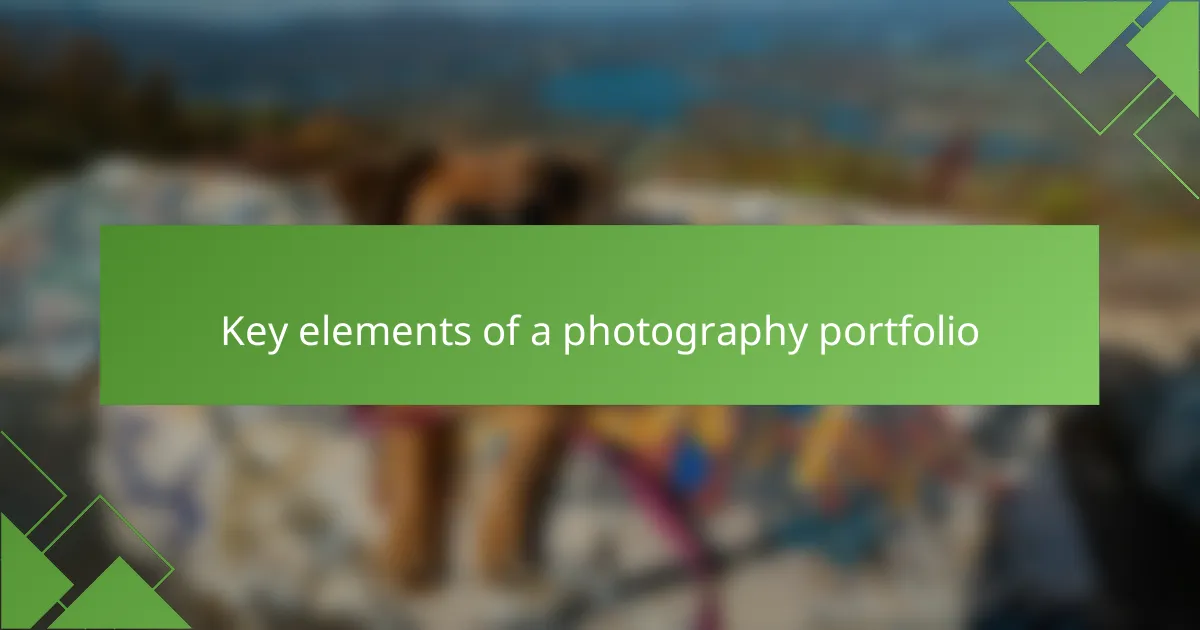
Key elements of a photography portfolio
When building a photography portfolio, one of the key elements I prioritize is cohesion. Every image should feel like part of a larger story. I remember the first time I curated my portfolio for an exhibition; I spent hours selecting images that not only showcased my technical skills but also shared a common theme. Did those pieces resonate with my vision? Absolutely, and that excitement still fuels my creative process.
Another vital aspect is presentation. The way you display your work can significantly impact how it’s perceived. I’ve experimented with various layouts, from minimalist to more eclectic styles, to find what best represents my artistry. At Cannes, the presentation of fashion pieces plays a crucial role; it’s often the dramatic flair that draws the eye. Similarly, your portfolio should reflect your personality and style, making an immediate impact on viewers.
Finally, I can’t stress enough the importance of versatility. A well-rounded portfolio demonstrates adaptability, which is essential in the photography world. I often revisit mine to include diverse genres—from landscapes to portraits. Each addition not only highlights my range but reminds me of how varied and exciting photography can be. Isn’t it fascinating how a single portfolio can capture so many different facets of our artistic journey?
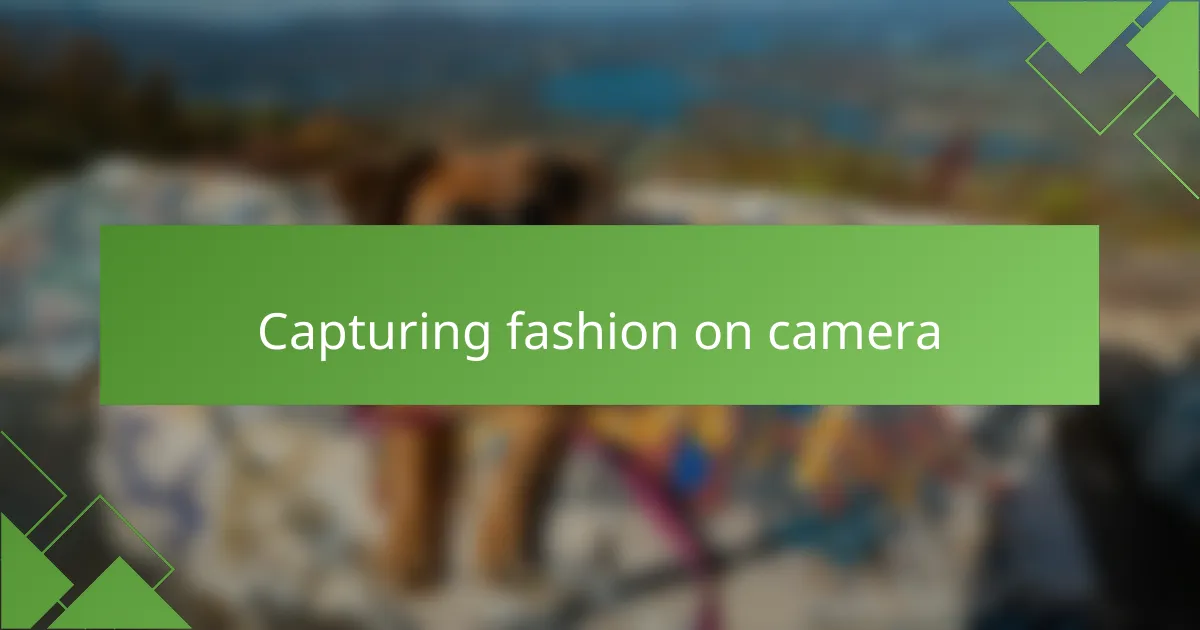
Capturing fashion on camera
Capturing fashion on camera is a unique blend of skill, intuition, and emotion. I remember the first time I stood among the glamorous crowd at Cannes. The energy was palpable, and every designer’s creation was a statement. I found myself entranced by the vivid colors and intricate details, eager to translate that vibrancy into my photographs.
I often think about the importance of timing in fashion photography. There’s a fleeting moment when a model’s expression or the drape of a gown creates magic. Capturing that essence can be challenging but rewarding. During my shoots, I sometimes feel almost like a conductor, orchestrating the perfect scene. Why do those moments matter so much? Because they encapsulate not just fashion, but the stories and emotions woven into every piece.
As I review my shots from events like Cannes, I notice how each image tells a different story while echoing a collective theme of creativity and elegance. It’s a reminder of how vital it is to immerse myself in the ambiance. Fashion is about more than just clothes; it’s about attitude and culture. I find that connecting with the atmosphere around me makes all the difference. Doesn’t it make you think about how a photograph can evoke a feeling or a moment in time? That’s truly the heart of fashion photography for me.
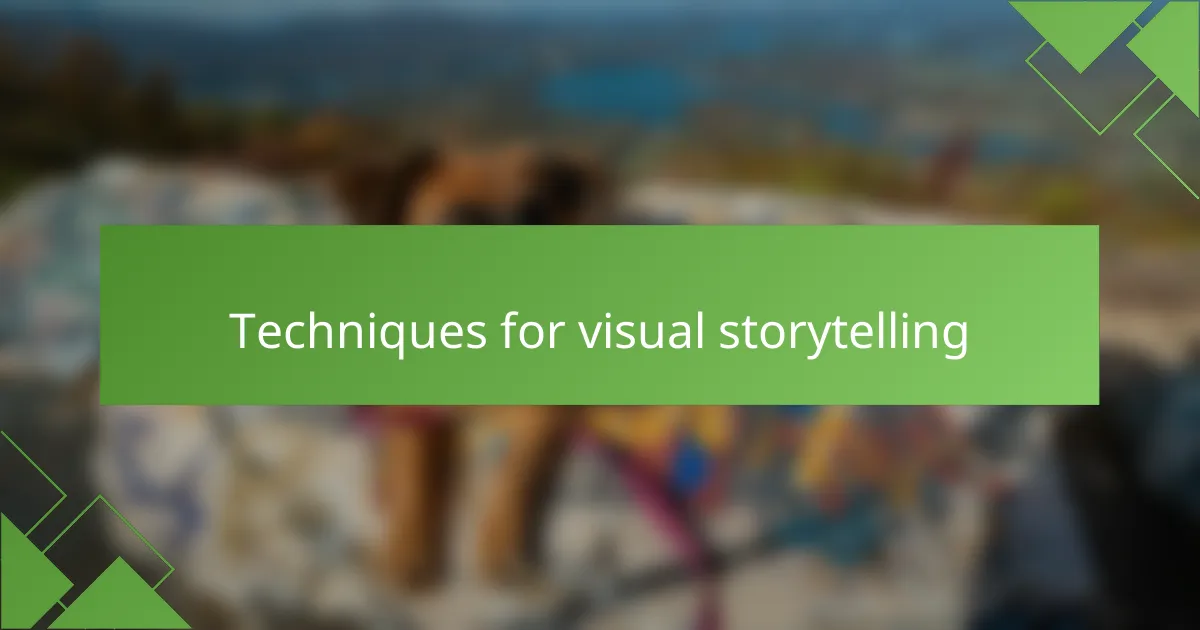
Techniques for visual storytelling
Engaging in visual storytelling requires a deep understanding of composition and light. Personally, I often find that the way light dances across a fabric can completely transform an image. For instance, while shooting at Cannes, I noticed how the soft golden hour light seemed to elevate the elegance of the gowns on display. Isn’t it amazing how just a shift in light can evoke different emotions and narratives within a single frame?
Another technique I cherish in visual storytelling is the use of perspective. By adjusting my angle, I can make a stunning gown appear almost ethereal or powerful, depending on what I want to convey. I remember capturing a breathtaking evening dress from below, and it created an awe-inspiring effect. It felt like I was not just photographing a piece of clothing but rather telling the story of a character—one who exudes strength and grace. Have you ever considered how perspective alters your perception of the subject?
Lastly, I believe that juxtaposition can be a powerful storytelling tool. I often explore contrasting elements, such as sleek fashion set against the rugged backdrop of Cannes’ historic architecture. This creates a dialogue between the modern and the classical, amplifying the visual narrative. When I look at such images, I can’t help but reflect on the dynamic interplay between styles and eras. It makes me wonder—how do we bridge the past with the present in our art?
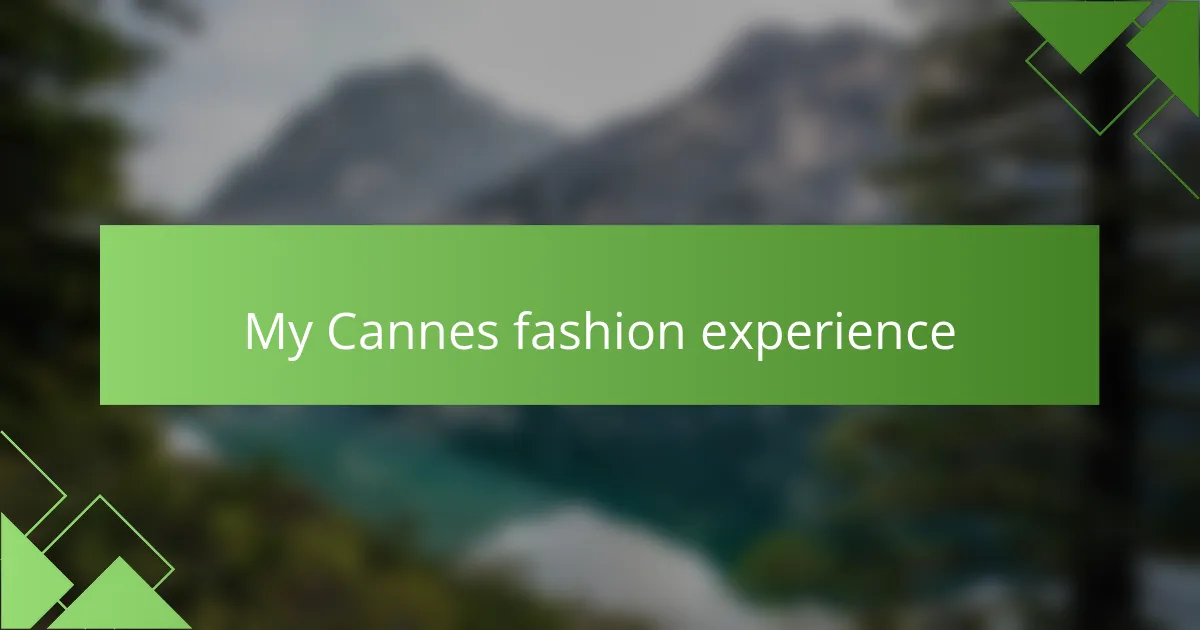
My Cannes fashion experience
Fashion in Cannes was a whirlwind of glamour and creativity. I remember arriving at the festival, feeling the excitement buzz in the air. Every outfit was a conversation starter, stories intertwined in the fabrics and designs. It struck me how each piece not only showcased artistry but also represented the individual spirit of the wearer. Have you ever felt so captivated by clothing that it almost feels alive? That’s what I experienced at Cannes, where fashion was not just seen but truly felt.
During the stunning events, I found myself noticing the striking contrasts between styles. Elegant gowns, daring cuts, and vibrant hues danced through the crowd, each telling its own tale. I couldn’t resist the urge to capture these moments, almost like collecting fragments of joy and inspiration. One particular photograph still stands out to me: a model in a flowing red dress against a backdrop of the deep blue Mediterranean. The contrast was breathtaking! Isn’t it fascinating how colors and settings can amplify the emotion of a single image?
Reflecting on my time in Cannes, I discovered the importance of connection. Talking to designers and models offered me fresh perspectives on their work. Their passion was infectious, igniting my own creativity. This personal engagement allowed me to see beyond the surface of glamour, appreciating the stories and efforts that went into every stitch. Have you ever experienced that connection in your own journey? It transforms not just your understanding, but also your artistry. Each click of the camera became a celebration of this rich tapestry of fashion, forever etched in my memory.